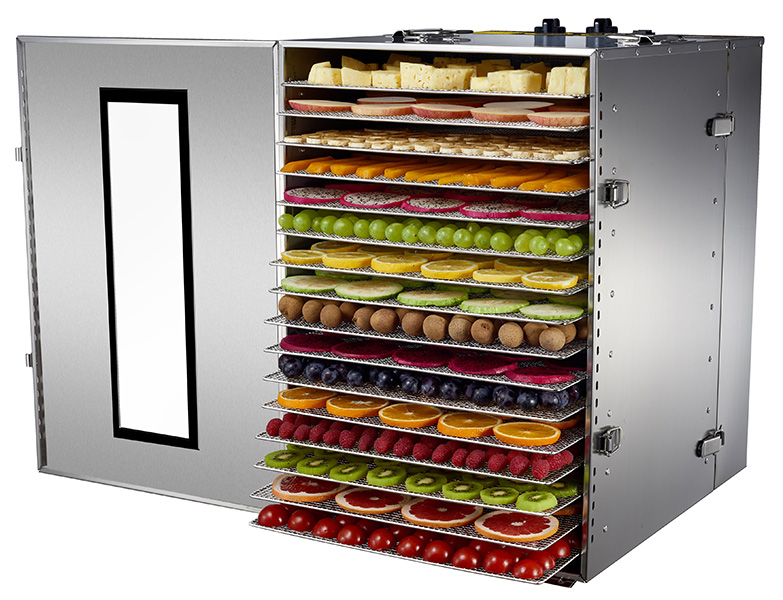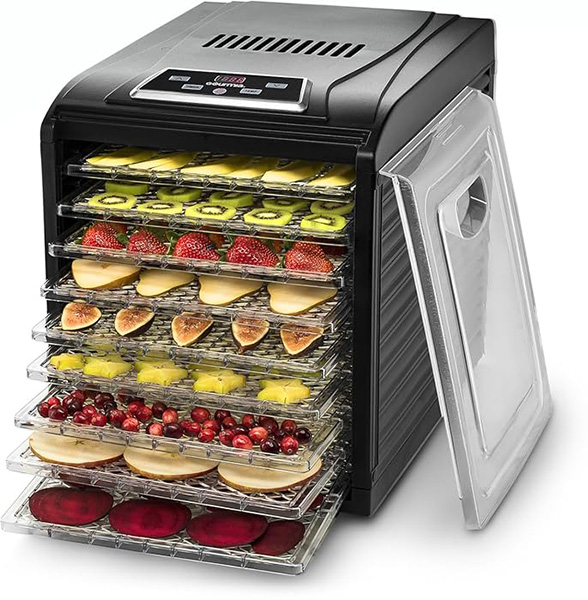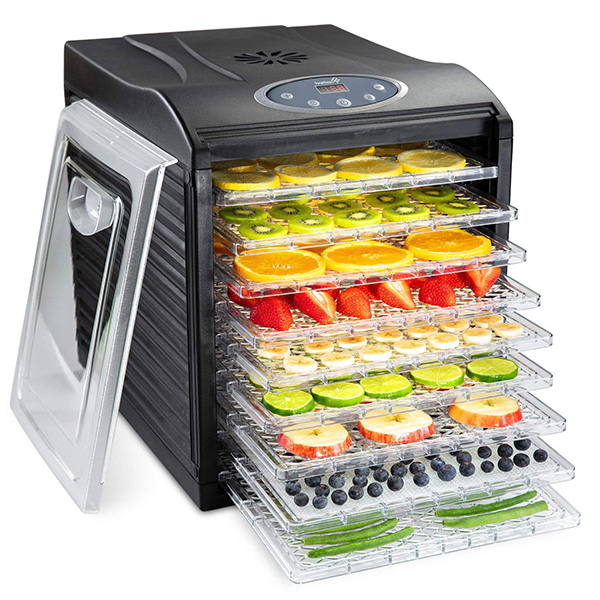
Content Menu
● Introduction to Fruit Dryer Machines
● Understanding the Technology Behind Fruit Dryer Machines
● Benefits of Using a Fruit Dryer Machine
● Choosing the Right Fruit Dryer Machine
● Types of Fruit Dryer Machines
● How to Use a Fruit Dryer Machine
● Popular Fruits and Vegetables for Drying
● Creative Uses for Dried Fruits and Vegetables
● Maintenance and Care of Your Fruit Dryer Machine
● The Future of Fruit Drying Technology
● Conclusion
● Frequently Asked Questions
Introduction to Fruit Dryer Machines
In today's fast-paced world, where convenience and health-conscious choices often intersect, fruit dryer machines have emerged as a game-changer in food preservation. These innovative appliances, also known as food dehydrators, have revolutionized the way we store and enjoy fruits, vegetables, and other perishables. Whether you're a health enthusiast, a culinary adventurer, or simply someone looking to reduce food waste, a fruit dryer machine can be an invaluable addition to your kitchen arsenal.

Understanding the Technology Behind Fruit Dryer Machines
At its core, a fruit dryer machine operates on a simple principle: it removes moisture from food items through a controlled process of heat and air circulation. This dehydration process not only extends the shelf life of fruits and vegetables but also concentrates their flavors and nutrients, resulting in delicious, healthy snacks.
Modern fruit dryer machines come in various sizes and configurations, from compact home units to large-scale industrial food dryers. Most models feature multiple trays or layers, allowing users to dry different types of produce simultaneously. The key components of a typical fruit dryer machine include:
1. Heating element
2. Fan for air circulation
3. Adjustable temperature controls
4. Timer
5. Removable, dishwasher-safe trays
Benefits of Using a Fruit Dryer Machine
The advantages of incorporating a fruit dryer machine into your lifestyle are numerous:
1. Preservation of seasonal produce
2. Reduction of food waste
3. Creation of healthy, preservative-free snacks
4. Cost savings on store-bought dried fruits
5. Versatility in food preparation
6. Compact storage of dried foods

Choosing the Right Fruit Dryer Machine
When selecting a fruit dryer machine, consider the following factors:
1. Capacity: Determine how much produce you plan to dry regularly.
2. Size: Ensure the machine fits comfortably in your kitchen space.
3. Temperature range: Look for models with adjustable temperature controls for different types of produce.
4. Noise level: Some machines can be noisy during operation.
5. Energy efficiency: Check the power consumption to avoid high electricity bills.
6. Additional features: Some models offer extra functions like automatic shut-off or preset drying programs.
Types of Fruit Dryer Machines
1. Stackable Tray Dehydrators: These are the most common type for home use, featuring multiple trays that can be added or removed as needed.
2. Shelf Dehydrators: Similar to mini-ovens, these units have fixed shelves and are often more energy-efficient.
3. Commercial Fruit Dehydrators: Designed for large-scale operations, these machines can handle significant quantities of produce.
4. Solar Dehydrators: Eco-friendly options that harness the power of the sun for drying fruits and vegetables.
How to Use a Fruit Dryer Machine
Using a fruit dryer machine is straightforward:
1. Wash and prepare your fruits or vegetables.
2. Slice the produce evenly for consistent drying.
3. Arrange the slices on the trays, ensuring they don't overlap.
4. Set the temperature and timer according to the type of produce.
5. Allow the machine to run its cycle, checking periodically for desired dryness.
6. Cool the dried fruits before storing in airtight containers.

Popular Fruits and Vegetables for Drying
While almost any fruit or vegetable can be dried, some popular choices include:
1. Apples
2. Bananas
3. Strawberries
4. Mangoes
5. Tomatoes
6. Kiwis
7. Pineapples
8. Bell peppers
9. Zucchini
10. Herbs (basil, oregano, thyme)
Creative Uses for Dried Fruits and Vegetables
Dried produce isn't just for snacking. Here are some innovative ways to use your dehydrated goodies:
1. Add to trail mixes and granola
2. Incorporate into baked goods
3. Use as toppings for yogurt or oatmeal
4. Grind into powders for natural food coloring
5. Create homemade tea blends
6. Use in savory dishes for intense flavor
Maintenance and Care of Your Fruit Dryer Machine
To ensure your fruit dryer machine operates efficiently and lasts long:
1. Clean the trays and interior after each use
2. Check and clean the air filters regularly
3. Store the machine in a dry place when not in use
4. Inspect the heating element and fan periodically
5. Follow the manufacturer's maintenance guidelines
The Future of Fruit Drying Technology
As technology advances, we can expect to see fruit dryer machines with even more sophisticated features:
1. Smart connectivity for remote operation and monitoring
2. Advanced sensors for optimal drying conditions
3. Integration with recipe apps for precise drying instructions
4. Improved energy efficiency and faster drying times
5. Compact, multi-functional designs for small kitchens
Conclusion
Fruit dryer machines have transformed the way we preserve and enjoy nature's bounty. From compact home units to industrial-scale dehydrators, these appliances offer a simple yet effective method of extending the life of our favorite fruits and vegetables. By investing in a quality fruit dryer machine, you're not just purchasing an appliance; you're embracing a lifestyle that values nutrition, reduces waste, and opens up a world of culinary possibilities.
Whether you're a health-conscious individual, a busy parent looking for wholesome snacks, or a culinary enthusiast eager to explore new flavors, a fruit dryer machine is a versatile tool that can enhance your kitchen and your diet. As we continue to seek ways to live more sustainably and healthily, the humble fruit dryer stands as a testament to how simple technology can make a significant impact on our daily lives.
So, why not take the plunge and explore the world of fruit drying? Your taste buds, your wallet, and the environment will thank you for it. Happy drying!
Frequently Asked Questions
1. Q: How long does it take to dry fruits in a fruit dryer machine?
A: The drying time varies depending on the type and thickness of the fruit, as well as the machine's settings. On average, it can take anywhere from 6 to 16 hours. Berries and thinly sliced fruits dry faster, while denser fruits like apples or pears may take longer.
2. Q: Are nutrients lost during the drying process?
A: While some nutrients, particularly vitamin C, can be reduced during drying, the process concentrates other nutrients. Dried fruits retain most of their fiber, minerals, and antioxidants, making them a nutritious snack option.
3. Q: Can I dry different fruits together in the same batch?
A: It's generally best to dry fruits with similar drying times and moisture content together. Mixing fruits with vastly different characteristics can result in uneven drying. However, many fruit dryer machines allow you to remove trays as needed, so you can start with various fruits and remove those that dry faster.
4. Q: How should I store dried fruits, and how long do they last?
A: Store dried fruits in airtight containers in a cool, dry place. Properly dried and stored fruits can last up to a year. For longer storage, you can keep them in the refrigerator or freezer.
5. Q: Is it safe to dry meat in a fruit dryer machine?
A: Many fruit dryer machines are versatile enough to handle meat for jerky making. However, it's crucial to follow proper food safety guidelines, including pre-treating the meat and ensuring it reaches the correct internal temperature during drying. Always consult your machine's manual and reliable food safety sources when drying meat.












